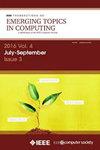Fully Parallel, One-Cycle Random Shuffling for Efficient Countermeasure Against Side Channel Attack and Its Complexity Verification
IF 5.4
2区 计算机科学
Q1 COMPUTER SCIENCE, INFORMATION SYSTEMS
IEEE Transactions on Emerging Topics in Computing
Pub Date : 2024-10-17
DOI:10.1109/TETC.2024.3478228
引用次数: 0
Abstract
Hiding countermeasures are the most widely utilized techniques for thwarting side-channel attacks. Commonly, the Fisher-Yates algorithm is adopted in hiding countermeasures with permuted operation for its security and efficiency in implementation, yet the inherently sequential nature of the algorithm imposes limitations on hardware acceleration. In this work, we propose a novel method named Addition Round Rotation (一种有效对抗侧信道攻击的全并行单周期随机洗牌算法及其复杂度验证
隐藏对抗是最广泛使用的技术,以挫败侧信道攻击。通常采用Fisher-Yates算法来隐藏具有排列操作的对抗措施,以提高其安全性和实现效率,但该算法固有的顺序性对硬件加速施加了限制。在这项工作中,我们提出了一种名为Addition Round Rotation ($\mathsf {ARR}$)的新方法,该方法可以与基于块的排列引入时区权衡。我们的研究结果表明,这种方法可以实现从$2^{128}$的排列蛮力复杂度水平,修改后的版本在单个时钟周期内达到$2^{288}$,同时保持对二阶分析的显著抵抗。为了验证所提出方法的安全性,我们引入了一种新的验证技术——身份验证。该技术可以从理论上验证所提出算法的安全性,并与实验结果相一致。最后介绍了一个实际的硬件设计,并给出了在专用集成电路(ASIC)上的实现结果。实测性能表明,我们的方案完全支持实际应用。
本文章由计算机程序翻译,如有差异,请以英文原文为准。
求助全文
约1分钟内获得全文
求助全文
来源期刊

IEEE Transactions on Emerging Topics in Computing
Computer Science-Computer Science (miscellaneous)
CiteScore
12.10
自引率
5.10%
发文量
113
期刊介绍:
IEEE Transactions on Emerging Topics in Computing publishes papers on emerging aspects of computer science, computing technology, and computing applications not currently covered by other IEEE Computer Society Transactions. Some examples of emerging topics in computing include: IT for Green, Synthetic and organic computing structures and systems, Advanced analytics, Social/occupational computing, Location-based/client computer systems, Morphic computer design, Electronic game systems, & Health-care IT.
 求助内容:
求助内容: 应助结果提醒方式:
应助结果提醒方式:


